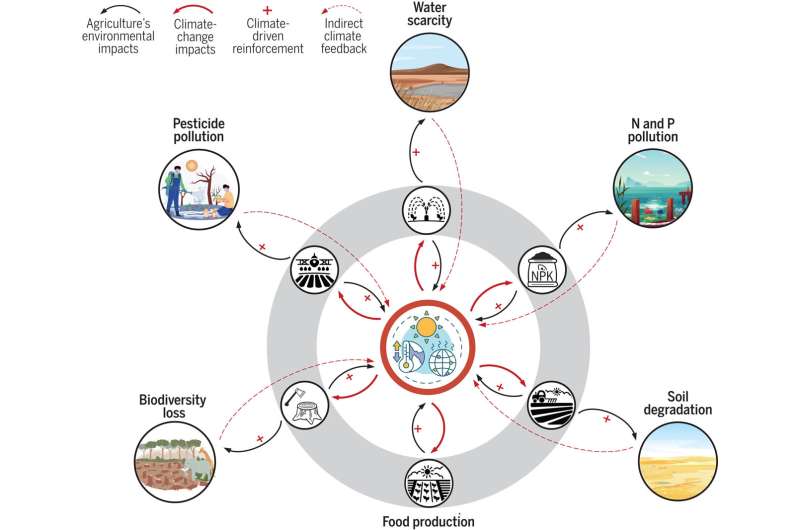This article has been reviewed according to Science X's editorial process and policies. Editors have highlighted the following attributes while ensuring the content's credibility:
fact-checked
peer-reviewed publication
trusted source
proofread
Sweeping global study charts a path forward for climate-resilient agriculture

Around the world, research on climate change and agriculture has revealed a complex two-way relationship. Global agriculture is a major driver of climate change, extinctions and pollution, and its influence on the environment is growing. At the same time, the flooding, droughts, and extreme temperatures resulting from climate change are beginning to threaten global food production.
Greenhouse gas emissions from agriculture are now 18 times higher than they were in the 1960s, accounting for about 30% of global warming. Excess fertilizer left on farm soil is broken down by bacteria to form nitrous oxide, a greenhouse gas that is 300 times more potent than carbon dioxide. Strategic efforts to reduce the warming impact of agriculture while maintaining high yields are essential to both mitigating climate change and protecting our food supply from its impacts.
A sweeping global research review published in Science, co-written by professors at the University of Minnesota with more than 20 experts around the world, has examined the links between climate and agriculture.
The study revealed the likelihood of an emergent feedback loop in which, as climate change puts more pressure on the global food supply, agriculture adopts practices that further accelerate climate change. The authors also identified new agricultural practices that have the potential to greatly reduce climate impacts, increase efficiency and stabilize our food supply in the decades to come.
The research found:
- Climate change has broad-ranging impacts on agricultural practices, increasing water use and scarcity, nitrous oxide and methane emissions, soil degradation, nitrogen and phosphorus pollution, pest pressure, pesticide pollution and biodiversity loss.
- Climate-agriculture feedback pathways could dramatically increase agricultural greenhouse gas emissions. Without changes in agriculture, this feedback loop could make it impossible to achieve the Paris Agreement goal of limiting global warming to 1.5 degrees Celsius to 2 degrees Celsius.
- Existing sustainable agricultural practices and technologies, if they are implemented on a wide scale, can greatly reduce agricultural emissions and prevent a feedback loop from developing. To achieve this, governments must work to remove socioeconomic barriers and make climate-resilient solutions accessible to farmers and food producers.
"We need agriculture, but the future of humanity also requires that we reduce agriculture's environmental harms," said co-author David Tilman, a professor at the College of Biological Sciences. "Fifty years ago the impacts of agriculture were trivial, but today they are not. By evaluating new practices being tried around the world—here in the U.S., in Mexico, the European Union and China—we have identified practices that appear to increase harvests while decreasing environmental harm.
"Once these new practices are tested and verified, we need a farm bill that pays farmers both for producing food and for improving the environment. Farmers are the stewards of 40% of the land on Earth. Enabling better stewardship has tremendous benefits for all of us."
"Legislation like the Inflation Reduction Act has provided resources to help our farms become more efficient," said co-author Zhenong Jin, an associate professor in the College of Food, Agricultural and Natural Resource Sciences.
"We looked at all aspects of this relationship between agriculture and climate to determine where new practices are the most effective. While carbon sequestration is currently a priority, an integrated approach that factors in farming efficiency and pollutants like nitrous oxide could deliver much larger climate benefits and a more stable future for agriculture. Practices such as precision fertilizer use and crop rotation can prevent a feedback loop from developing."
The team identified a number of next steps. First and foremost, stakeholders should accelerate the adaptation and cost-reduction of efficient and climate-friendly agriculture. Precision farming, perennial crop integration, agrivoltaics, nitrogen fixation, and novel genome editing are among the emerging techniques that could increase production and efficiency in agriculture while reducing climate change impacts.
The researchers recommend further research on climate–agriculture feedback pathways and new technologies like on-farm robots.
More information: Yi Yang et al, Climate change exacerbates the environmental impacts of agriculture, Science (2024). DOI: 10.1126/science.adn3747
Journal information: Science
Provided by University of Minnesota




















